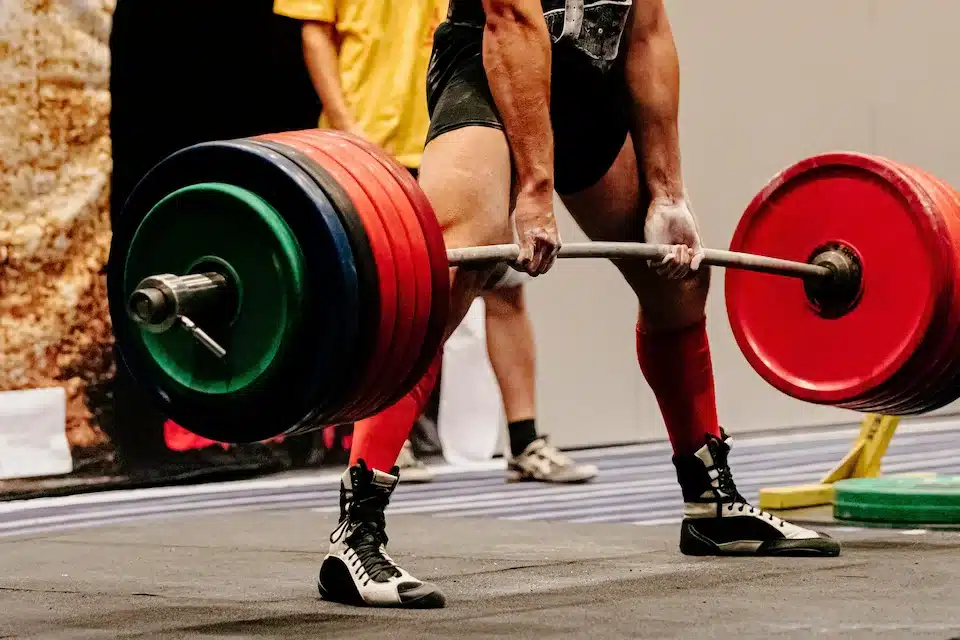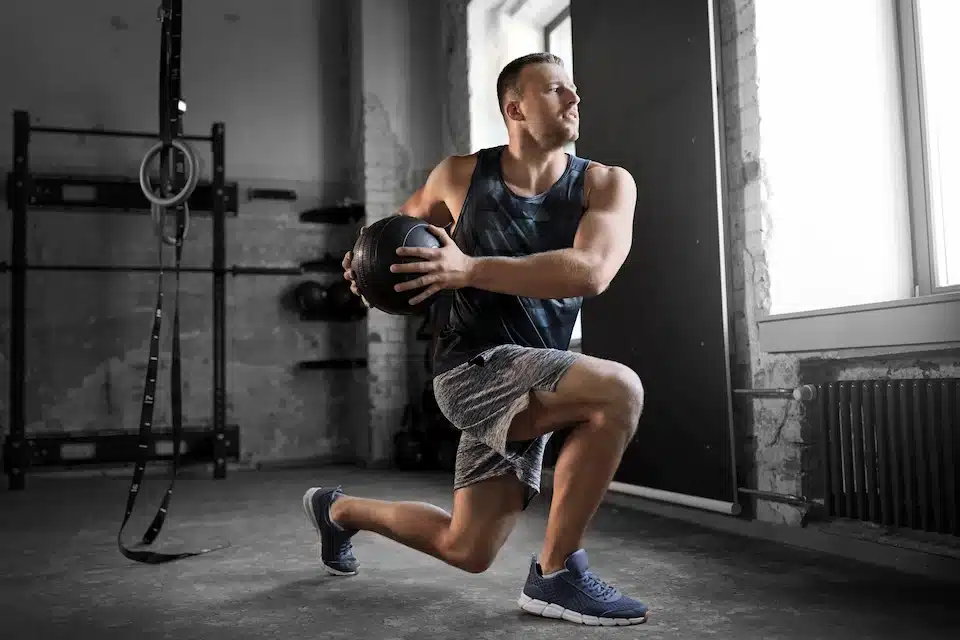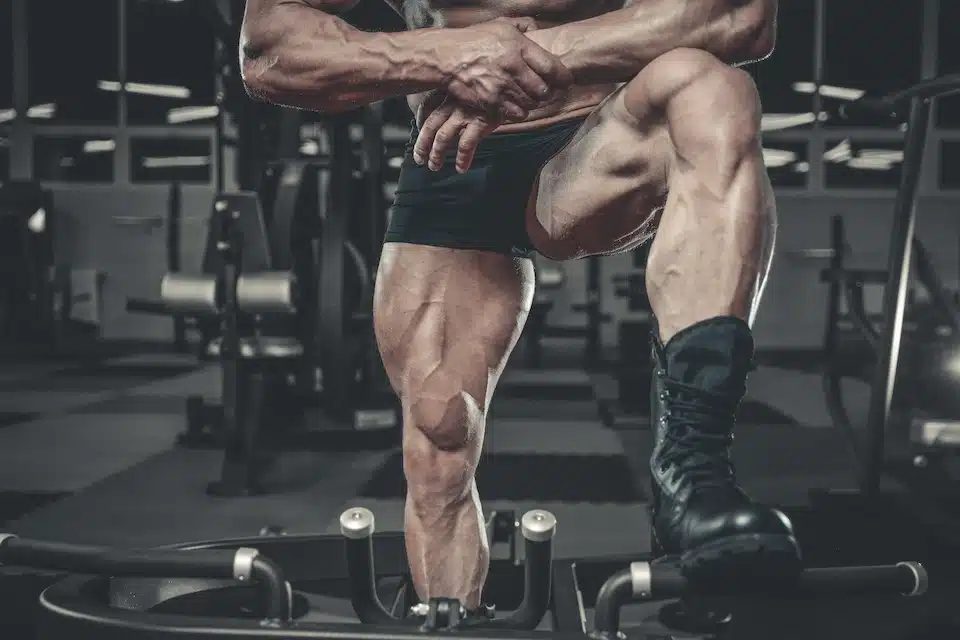Preparing for a powerlifting competition can be tough. A 16 week powerlifting program helps you build strength and size. This guide breaks down each phase to get you ready for your best lift.
Let’s get started!
- Overview of the 16-Week Powerlifting Program
- Detailed Weekly Breakdown
- Weeks 1-6: Building a Strong Base
- Focus on compound movements
- Gradual increase in weight and volume
- Weeks 7-12: Enhancing Power and Technique
- Implementation of speed work
- Introduction of more complex lifts
- Weeks 13-16: Preparation for Competition
- Tapering volume while maintaining intensity
- Simulation of meet conditions
- Essential Exercises and Their Roles
- Importance of Recovery and Nutrition
- Equipment and Gear Recommendations
- Mental Preparation Strategies
- Understanding Powerlifting Competitions and Scoring
- Common Mistakes to Avoid
- Conclusion
- FAQs
Key Takeaways
- The program lasts 16 weeks and has three phases: foundation, intensity, and peaking.
- In the first six weeks, aim to squat 180 kg, bench press 140 kg, and deadlift 220 kg.
- Phase two includes a rest week, testing max lifts, and using the 5/3/1 method to build strength.
- The last four weeks focus on reducing workout volume, keeping weights heavy, and practicing competition lifts.
- Proper recovery with 7-9 hours of sleep and a balanced diet is essential for success.
Overview of the 16-Week Powerlifting Program
The 16-week powerlifting program is organized into three phases. You will focus on squatting, bench pressing, and deadlifting to get ready for competition.
Phase 1: Foundation and Strength Building (Weeks 1-6)
During the first six weeks, build a strong base with key lifts. Focus on squats, bench presses, and deadlifts. Use a classic bodybuilding split with powerlifting variations. Start with lighter weights and add more each week.
Aim to squat 180 kg, bench press 140 kg, and deadlift 220 kg by week six. Include exercises like lying triceps extensions to prevent injuries. Gradually increase the weight and volume to strengthen your physique and prepare for the next phase.
Phase 2: Intensity Increase and Skill Refinement (Weeks 7-12)
Phase 2 starts with Week 7, a rest week. Take time off from heavy lifting. Let your muscles heal. In Week 8, test your max lifts every day. Do 5 sets of 5 reps at 60%. This helps build strength and technique.
From Weeks 9 to 12, follow the 5/3/1 method. Increase your weights each week. Add speed work and complex lifts like box squats. Focus on deadlifted and squatted movements. Powerlifters use these techniques to refine their skills and boost power.
Consistency is key to powerlifting success.
Phase 3: Peaking and Tapering (Weeks 13-16)
Weeks 13 and 14 focus on maintaining strength while reducing workout volume. Lift heavy to stay sharp for the competition. Practice your squat, bench press, and deadlift as you will on competition day.
Use techniques from Louie Simmons and Westside Barbell to boost your performance.
Week 15 is a rest week. Take time off to recover fully. In Week 16, perform EDM testing and complete a 5×5 routine at 60%. This prepares you to achieve your personal record (PR) at the meet.
Follow weightlifting protocols and keep your powerlifting and powerbuilding goals strong.
Detailed Weekly Breakdown
Follow the weekly schedule to boost your squats, bench presses, and deadlifts. The plan changes intensity and exercises to build your power step by step.
Weeks 1-6: Building a Strong Base
Weeks 1-6 focus on compound movements. Squats, bench presses, and deadlifts form the core. Use a classic bodybuilding split with powerlifting variations. Gradually increase weight and volume each week.
This builds strength and sets a foundation for heavier lifts.
Aim to raise your power lifting PRs steadily. Incorporate accessory exercises to prevent injuries. Balance workouts to target all major muscle groups. Track your progress to stay on course.
Building a strong base is essential for lifting heavier weights.
Focus on compound movements
Compound movements like squats, bench press, and deadlifts are the backbone of any powerlifting program. These exercises engage multiple muscle groups, boosting overall strength and building a solid foundation.
Focusing on compound movements helps you develop the power and technique needed to lift heavier weights and achieve new personal records (PR).
Include high intensity and volume in your workouts to maximize gains. Gradually increase the weight to challenge your muscles while keeping good form. Bodybuilding techniques also support powerlifting by promoting muscle growth and reducing the risk of injury.
Prioritizing compound movements sets you up for success in competition preparation.
Gradual increase in weight and volume
After focusing on compound movements, steadily increase the weight and volume each week. Add 2.5 kg to 5 kg to your lifts every session. This gradual ramp builds strength and lowers injury risk.
Use autoregulation to adjust the load based on how you feel. Tracking your workouts helps set new personal records (pr) during the bodybuilding phases.
Weeks 7-12: Enhancing Power and Technique
Building on the strong base, Weeks 7-12 focus on power and technique. Week 7 is a rest week to help muscles recover. In Week 8, athletes test their maxes every day and do 5×5 workouts at 60% of their PRs.
Speed work is added to improve explosive strength. More complex lifts are introduced to refine technique. This phase helps lifters increase their power and perfect their form for competition.
“Strength does not come from physical capacity. It comes from an indomitable will.” – Mahatma Gandhi
Implementation of speed work
In weeks 7-12, speed work boosts your strength by increasing bar speed. Use weights at 50-60% of your one-rep max (1RM). Perform 6-8 sets of 2-3 reps, focusing on moving the bar quickly.
This method helps improve your power and prepares you for heavier lifts.
Paul Carter’s Base Building approach inspires this phase. Speed work complements main lifts like squats, bench presses, and deadlifts. Track your personal records (PR) regularly to monitor progress.
Incorporate accessory exercises to support your body building goals and prevent injuries.
Introduction of more complex lifts
Introducing more complex lifts enhances your strength and technique. Exercises like pause squats, deficit deadlifts, and close-grip bench presses target specific muscles. Using the 5/3/1 method, you follow structured sets and reps to build steadily.
Gradually increase the weight to push your personal record (PR). This strategy ensures consistent progress and prepares you for competition day.
Weeks 13-16: Preparation for Competition
Focus shifts to preparing for the meet during weeks 13-16. Taper your training volume but keep the intensity high. Practice your lifts under competition-like conditions to build confidence and refine your technique.
In week 15, take a rest week to allow your body to recover fully. During week 16, perform EDM testing and complete 5×5 sets at 60% to set your pr (personal record). This final week ensures you are ready and strong for competition day.
Success in powerlifting comes from consistent preparation and unwavering focus.
Tapering volume while maintaining intensity
In weeks 13 to 16, reduce your training volume by about 30%. Decrease the number of sets and reps each session. Keep the weights heavy to maintain intensity. This strategy helps your muscles recover while preserving strength.
Maintain high effort on each lift to stay competition-ready. Practice lifts as you would in the meet to simulate competition conditions.
Next, explore the essential exercises and their roles in your powerlifting program.
Simulation of meet conditions
Run mock meets regularly. Follow official commands and timing. Wear your competition shoes and belt. Perform EDM testing each session. Track your lifts to monitor progress. This helps you get ready for the real competition.
Next, explore essential exercises and their roles.
Essential Exercises and Their Roles
Essential exercises like squats, bench presses, and deadlifts build your strength and keep you safe—keep reading to see how they fit into your program.
Squats, Bench Press, and Deadlifts
Squats, bench press, and deadlifts are the main lifts in powerlifting. They work many muscles at the same time. Aim to squat 180 kg, bench press 140 kg, and deadlift 220 kg. These targets build strength and prepare you for competition.
Regularly performing these lifts increases your power and improves your technique.
Focusing on these compound movements ensures balanced muscle growth. Proper form is crucial to lift safely and effectively. Train each lift consistently, and track your progress to reach your goals.
Accessory Movements for Injury Prevention
Include dumbbell rows to enhance back symmetry over six weeks. Commit to these exercises every week to build muscle balance. Strengthened muscles reduce the risk of injury during heavy lifts.
Incorporate other movements like lunges and planks to support joint stability and overall resilience.
Next, focus on recovery techniques to maximize your training results.
Importance of Recovery and Nutrition
Recovery means getting enough sleep and rest days, while proper nutrition with balanced meals fuels your training—read on to learn more.
Recovery Techniques: Active rest, sleep, and deload weeks
Active rest includes light activities like walking, stretching, or cycling. It keeps your body moving without overworking your muscles. Sleep is essential for muscle repair and growth.
Aim for 7 to 9 hours each night. Weeks 7 and 15 are deload weeks. These weeks lower your training volume and intensity. Deload weeks help your body supercompensate, building more strength.
Use these weeks to rest fully or do easy workouts. Up next, we’ll look at nutritional strategies.
Nutritional Strategies: Caloric intake, macronutrient balance
Maintain a caloric surplus to maximize strength gains during the 16-week program. This provides the energy needed for intense training and muscle growth. Alternatively, training at maintenance or a slight deficit can still produce gains while managing body weight.
Adjust your calories based on your goals and how your body responds.
Balance your macronutrients to support training and recovery. Aim for sufficient protein to build muscle, carbohydrates to fuel your workouts, and healthy fats for overall health. Proper macronutrient ratios enhance performance and speed up recovery, ensuring you stay strong and energized throughout the program.
Equipment and Gear Recommendations
Selecting the right gear—such as a reliable lifting belt and supportive shoes—is essential for your training success, so keep reading to find our top recommendations.
Choosing the Right Weightlifting Belt
Choose a belt that fits snugly around your waist. Select a width of 4 to 6 inches for proper support. Leather belts offer durability, while nylon belts provide more flexibility. Measure your waist to find the right size.
Pick a buckle that stays secure during lifts. Prong and lever buckles are popular choices. Ensure the belt supports your back and core. Try different belts to find the most comfortable and effective one.
Importance of Proper Footwear
Alongside the right weightlifting belt, proper footwear plays a crucial role in competition prep. Specialized lifting shoes provide stability during heavy lifts, supporting your feet to prevent injuries.
The right shoes enhance performance by improving grip and balance, ensuring each lift is secure and efficient. Proper footwear also influences lifting technique, helping maintain form and maximize strength.
Inappropriate shoes can decrease performance and increase the risk of falls. Without necessary support, such footwear makes it harder to stabilize during lifts. This can lead to poor technique and potential injuries.
Choosing specialized lifting shoes boosts performance and makes the powerlifting experience safer and more effective.
Mental Preparation Strategies
Master visualization and set goals to stay focused and calm under pressure—learn more below.
Visualization Techniques
Visualization techniques play a key role in preparing mentally for powerlifting. Athletes imagine successful lifts and competition scenes. This mental imagery boosts focus and builds confidence during intense training.
Using visualization with physical training improves results. A strong mind helps manage stress. Visualizing lifts prepares athletes for competition day.
Coping with Competition Pressure
Building on visualization techniques, managing competition pressure is crucial for success. Use deep breathing to stay calm before your lifts. Practice positive self-talk to boost your confidence.
Set a consistent pre-competition routine to maintain focus.
Seek support from coaches and teammates to navigate stressful moments. Break down your goals into small steps to make them achievable. Stay present by concentrating on each lift, one at a time.
These strategies help you handle pressure and perform your best.
Understanding Powerlifting Competitions and Scoring
Powerlifting competitions feature three main lifts: squat, bench press, and deadlift. Each lifter has three attempts for each lift. The highest successful lift in each category counts toward their total score.
Judges evaluate each lift to ensure proper form and technique.
Competitors are divided into different weight classes to ensure fair matches. Scoring is based on the total of the best squat, bench press, and deadlift. Rankings are determined by these totals, with the highest scores winning.
Understanding these rules helps prepare for competition day.
Common Mistakes to Avoid
Many lifters struggle with overtraining and poor technique. Avoid these errors to boost your performance and excel in competition.
Overtraining and Under-recovery
Rest weeks are crucial for muscle recovery and strength gains. Week 7 and Week 15 are scheduled as off weeks. These breaks help your body supercompensate and grow stronger.
Overtraining leads to fatigue and injuries. Under-recovery prevents your muscles from fully healing. Follow the program’s rest weeks to ensure steady progress and avoid setbacks.
Neglecting Technique for Heavier Weights
Lifting heavier weights without proper technique can lead to injuries and stalled progress. Proper form ensures that you target the right muscles and move the bar efficiently. Paul Carter’s Base Building approach emphasizes building a strong foundation with correct technique before increasing weight.
Focusing on the speed of the bar helps improve strength gains and maintain control during lifts. Ignoring technique may cause you to miss lifts or develop bad habits that are hard to fix later.
To avoid these issues, prioritize your form in every session. Use lighter weights to practice movements and gradually add more once your technique is solid. This strategy enhances performance and prepares you safely for competition conditions.
Conclusion
This 16-week plan guides you to powerlifting success. Each phase builds your strength and sharpens your skills. Prioritize training, rest, and good nutrition. Stick to the program and compete with confidence.
Reach your powerlifting goals strong.
FAQs
1. What does the 16-week powerlifting program for competition prep include?
The program includes structured training cycles focused on the squat, bench press, and deadlift. It also incorporates accessory exercises to build strength and improve technique.
2. How should I schedule my workouts during the 16 weeks?
Workouts are divided into phases with increasing intensity and varying volume. This approach helps peak your strength levels by competition day.
3. What nutrition guidelines should I follow while preparing for competition?
Maintain a balanced diet with enough protein, carbohydrates, and fats. Proper nutrition supports your training, aids recovery, and helps build muscle.
4. How can I track my progress throughout the 16-week program?
Use a training log to record your weights, sets, and reps. Regularly review your progress to make necessary adjustments and stay on track for competition.







